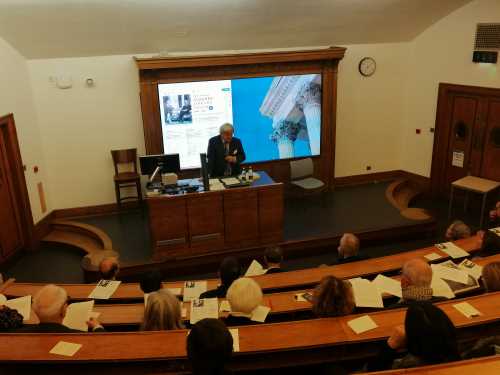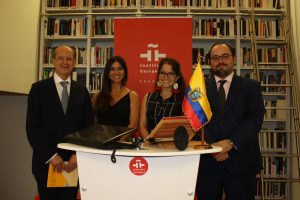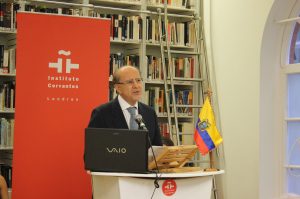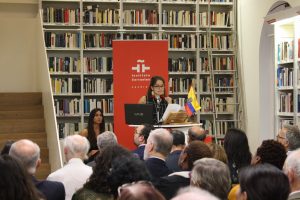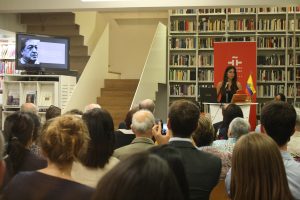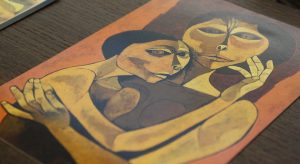Jiménez Fraud returns to London, Oxford and Cambridge with the publication of Epistolary

The United Kingdom hosted the presentation of the Epistolary (1905-1964) of Alberto Jiménez Fraud over three days of events in London, Oxford and Cambridge. The events were organised by Magdalen College alongside la Residencia de Estudiantes and the Free Institution of Education in collaboration with the Ministry of Education of the Embassy of Spain in the United Kingdom. Instituto Cervantes in London also collaborated as part of the ongoing celebrations for the 80th anniversary of the Spanish Republican exile.
Jiménez Fraud directed the Residencia de Estudiantes from its foundation in 1910 until 1936 when it became, according to Julio Caro Baroja, the first cultural centre in Spain. Throughout those decades Fraud mentored several generations of university students including, Severo Ochoa, Dalí, García Lorca or Buñuel, among many other exceptional residents. They presented theories at the Residencia, talking and working with some of the most outstanding International intellectuals, scientists and creators of the moment: Albert Einstein, Marie Curie, Walter Gropius, Paul Valéry, Alexander Calder.
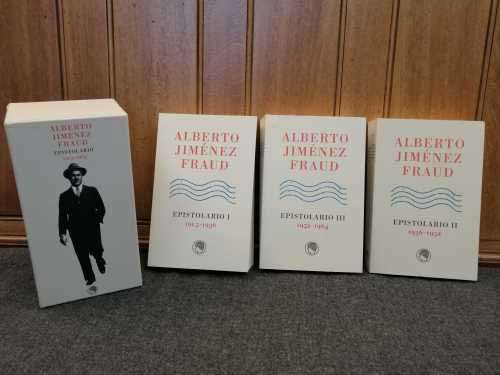
Exile in England
The outbreak of the Spanish Civil War forced the Residencia to stop its activity and forced Jiménez Fraud into exile with his family. They fled to England where he worked as a Lecturer in the Sub-Faculty of Spanish at the University of Oxford.
The Epistolary is a collection of over two thousand letters, offering an insight and new data into the modernisation of Spanish society and its recovery process in post-war Spain. The letters present an overview of the culture of the twentieth century through their multiple correspondents and dialogues.
The protagonists of Spanish and European intellectual history parade through its pages as close family and friends of Jiménez Fraud such as his teacher Giner de los Ríos. The list is long and impressive, including letters from: Manuel B. Cossío, José Moreno Villa, Zenobia Camprubí, Juan Ramón Jiménez, Natalia Cossío or Gloria Giner, along with Ortega and Gasset, Unamuno, Falla, Ramón y Cajal, Menéndez Pidal, María de Maeztu and Américo Castro.
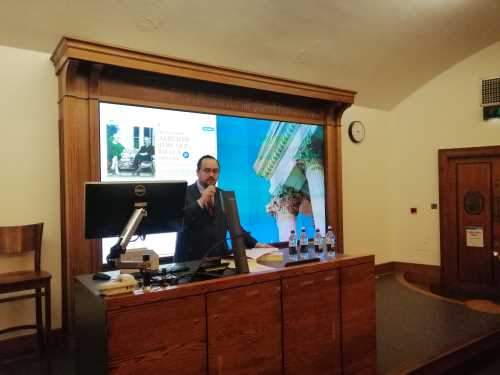
“The collection of letters gathered in the Jiménez Fraud Epistolary is an impressive academic work that deserves all forms of praise for both publishers and publishing houses, since it is an outstanding contribution to Spanish intellectual and cultural history during the twentieth century, and it is also a very interesting book from the point of view of Spanish-British relations,” said the director of Instituto Cervantes in London, Ignacio Peyró.
Elisa Navas, director of the Francisco Giner de los Ríos Foundation, stressed the importance of the three volumes of the Alberto Jiménez Fraud Epistolary, for the abundant information hitherto unknown about the modernisation project born from the Free Institution of Education of which the Residencia was an emblem.
Jiménez Fraud’s letters, which fluctuate between public and private, are included in the collection of epistolary published by the Residencia, in an attempt to achieve the most complete body of correspondence of the most relevant figures of the so-called Age of Silver of the Spanish culture: the period from 1868 to 1936, the brightest period after the Golden Age.
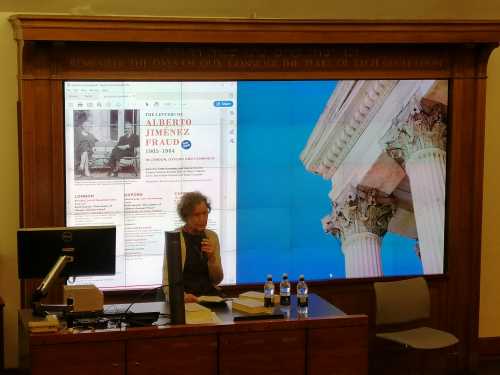
For Navas, the epistolary meets the rescue objective that encouraged the life and work of Jiménez Fraud when he had to leave the Residencia in September 1936, considering it essential to recover the memory of the institutions and the transmission of his legacy to the new generations of Spaniards, with the dream that one day they could reap their fruit in a free and democratic Spain.
García-Velasco and Valender
For José García-Velasco, the Higher Council for Scientific Research has always been linked to the Residencia. He explained how Jiménez Fraud’s struggle to recover the Residencia project until his death in 1964 informed the entirety of his exile in England. His legacy is still alive in the current Residencia de Estudiantes and the Free Institution of Education, both restored the Spanish democratic and European generations.
García-Velasco also stressed the value and importance of the precious testimonies in the epistolary of Jiménez Fraud. The first volume includes letters written during the period prior to the Spanish Civil War, and the following volumes, with correspondence between Jiménez Fraud and its recipients reflecting on the events that occurred between 1910 and 1636 since his exile.
In addition, García-Velasco mentioned the scholarship programme created by the Board for the Expansion of Studies, between 1907 and 1936, which granted about 3,000 scholarships (then called pensions) to centres of excellence in Europe and the United States. Thanks to these networks, the Residencia served as host to prestigious figures of the contemporary academic, scientific and artistic fields.
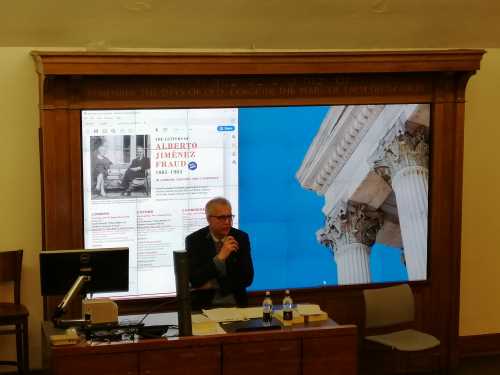
For his part, the Spanish literature professor at El Colegio de México and respected hispanist, James Valender, highlighted the value of the individual as well as the community angles represented by Jiménez Fraud in his letters. “Don Alberto (as his colleagues call him), is undoubtedly one of the figures who did more to promote Spanish culture and education in the first half of the twentieth century and was also a man who fled from fame and public recognition with the same determination with which others, with much less merit than him,” said Valender.
Jiménez Fraud vuelve con su Epistolario a Londres, Oxford y Cambridge

Reino Unido acogió la presentación del Epistolario (1905-1964) de Alberto Jiménez Fraud, en tres días de eventos en Londres, Oxford y Cambridge organizados por el Magdalen College, la Residencia de Estudiantes y la Institución Libre de Enseñanza en colaboración con la Consejería de Educación de la Embajada de España en el Reino Unido y el Instituto Cervantes de Londres, en el marco del 80 aniversario del exilio republicano español.
Jiménez Fraud dirigió la Residencia de Estudiantes desde su fundación en 1910 hasta 1936, cuando se había convertido, según Julio Caro Baroja, en el primer centro cultural de España. A lo largo de esos decenios, en los que fue mentor de varias generaciones de universitarios (Severo Ochoa, Dalí, García Lorca o Buñuel, entre otros muchos residentes excepcionales), en la Residencia expusieron sus teorías o presentaron sus obras algunos de los más destacados intelectuales, científicos y creadores internacionales del momento: Albert Einstein, Marie Curie, Walter Gropius, Paul Valéry, Alexander Calder…

Exilio en Inglaterra
El estallido de la guerra civil obligó a la Residencia a detener su actividad y a Jiménez Fraud a exiliarse con su familia en Inglaterra, donde trabajó como Lecturer en la Sub-Faculty of Spanish de la Universidad de Oxford.
Este epistolario, que recoge dos mil cartas, ofrece nuevos datos acerca del plan de modernización de la sociedad española y sobre su proceso de recuperación en la España posterior a la guerra. Las cartas presentan un panorama de la cultura del siglo XX a través de sus corresponsales.
Por sus páginas desfilan algunos de los protagonistas de la historia intelectual española y europea: familiares y amigos de Jiménez Fraud como su maestro Giner de los Ríos, Manuel B. Cossío, José Moreno Villa, Zenobia Camprubí, Juan Ramón Jiménez, Natalia Cossío o Gloria Giner, junto a Ortega y Gasset, Unamuno, Falla, Ramón y Cajal, Menéndez Pidal, María de Maeztu, Américo Castro… o los más jóvenes Caro Baroja o Valente.

“La colección de cartas reunidas en el Epistolario de Jiménez Fraud es una impresionante obra académica que merece toda forma de elogio tanto para los editores como para la editorial, ya que es una contribución destacada a la historia intelectual y cultural española durante el siglo XX, y también es un libro muy interesante desde el punto de vista de las relaciones hispano-británicas”, destacó el director del Instituto Cervantes de Londres, Ignacio Peyró.
Elisa Navas, directora de la Fundación Francisco Giner de los Ríos, subrayó la importancia de los tres volúmenes del epistolario de Alberto Jiménez Fraud, por la abundante información hasta ahora desconocida sobre el proyecto de modernización nacido de la Institución Libre de Enseñanza del que la Residencia fue emblema.
Las cartas de Jiménez Fraud, que fluctúan entre lo público y lo privado, se engloban dentro de la colección de epistolarios que publica la Residencia, en un intento por conseguir el corpus más completo de la correspondencia de las figuras más relevantes de la llamada Edad de Plata de la cultura española: el período de 1868 a 1936, el período más brillante después del Siglo de Oro.

Para Navas, el epistolario cumple con el objetivo de rescate que animó la vida y la obra de Jiménez Fraud cuando tuvo que abandonar la Residencia en septiembre de 1936, considerando imprescindible recuperar la memoria de las instituciones y la transmisión de su legado a las nuevas generaciones de españoles, con el sueño de que un día podrían recoger su fruto en una España libre y democrática.
García-Velasco y Valender
En el caso de José García-Velasco, del Consejo Superior de Investigaciones Científicas y siempre ligado a la Residencia, explicó la lucha de Jiménez Fraud desde el exilio para recuperar el proyecto de la Residencia hasta su muerte en 1964 y cómo su legado sigue vivo en la actual Residencia de Estudiantes y en la Institución Libre de Enseñanza, ambas restauradas para las generaciones democráticas y europeas españolas.
García-Velasco subrayó la importancia de los testimonios de precioso valor en el epistolario de Jiménez Fraud, con un primer volumen con cartas escritas durante el período previo a la Guerra Civil española, y los siguientes volúmenes, con la correspondencia entre Jiménez Fraud y sus destinatarios reflejando en los eventos ocurridos entre 1910 y 1636 desde el exilio.
Además, García-Velasco mencionó el programa de becas creado por la Junta para la Ampliación de Estudios, entre 1907 y 1936, que concedió unas 3.000 becas, llamadas en aquel entonces pensiones, a centros de excelencia en Europa y Estados Unidos. Gracias a estas redes, la Residencia sirvió de anfitriona a figuras prestigiosas del campo académico, científico y artístico del momento.

Por su parte, el profesor de Literatura española de El Colegio de México y respetado hispanista, James Valender, resaltó los aspectos individuales y colectivos que Jiménez Fraud contó en sus cartas. “Don Alberto (como lo llaman sus colegas), es sin duda alguna uno de las figuras que hizo más por promocionar la cultura española y la educación en la primera mitad del siglo XX y además, fue un hombre que huyó de la fama y del reconocimiento público con la misma determinación con la que otros, con muchos menos méritos de los que presumir, fueron constantemente el centro de atención”, destacó Valender.
Belen Cao, the Spanish designer at the National Gallery’s exhibitions
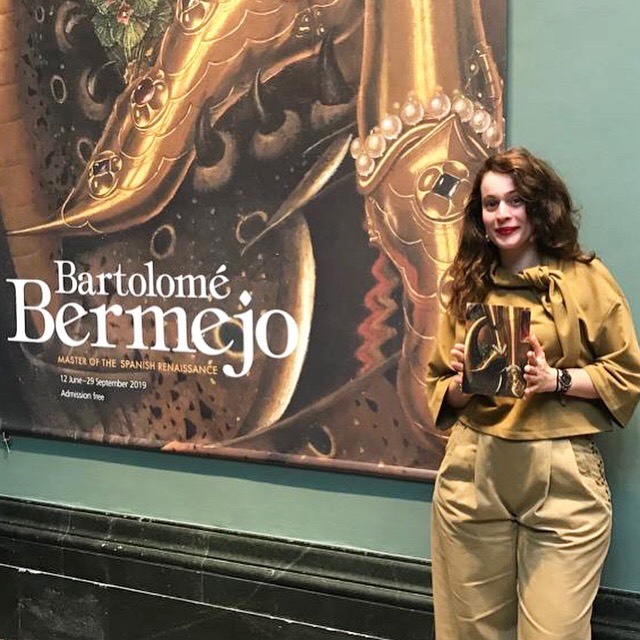
Belen Cao has always been fascinated by both writing and drawing and studied a degree in Journalism and Audiovisual Communication from the Antonio de Nebrija University in Madrid (2009). Since then, she has worked in small press offices and, in doing so, she began to redirect her career towards Graphic Design.
In 2012, Cao completed a one-year professional Masters in this subject at the Trazos school in Madrid. Followed by a year in Digital Illustration at the ESDIP school in Madrid (2014) and finally, a Master of the Arts at Kingston University, London in Graphic Design and Visual Communication in which she graduated with honors in 2016. Her academic studies have also been informed by extracurricular learning such as courses in animation, drawing, typography and printing methods.
Cao began her career at London’s National Gallery in December 2016 after a brief period of volunteering as an art teacher at an elementary school in South East London. She combined the volunteering with freelance designer work for Associated Studios, a training school for Young students of Theater and Opera.
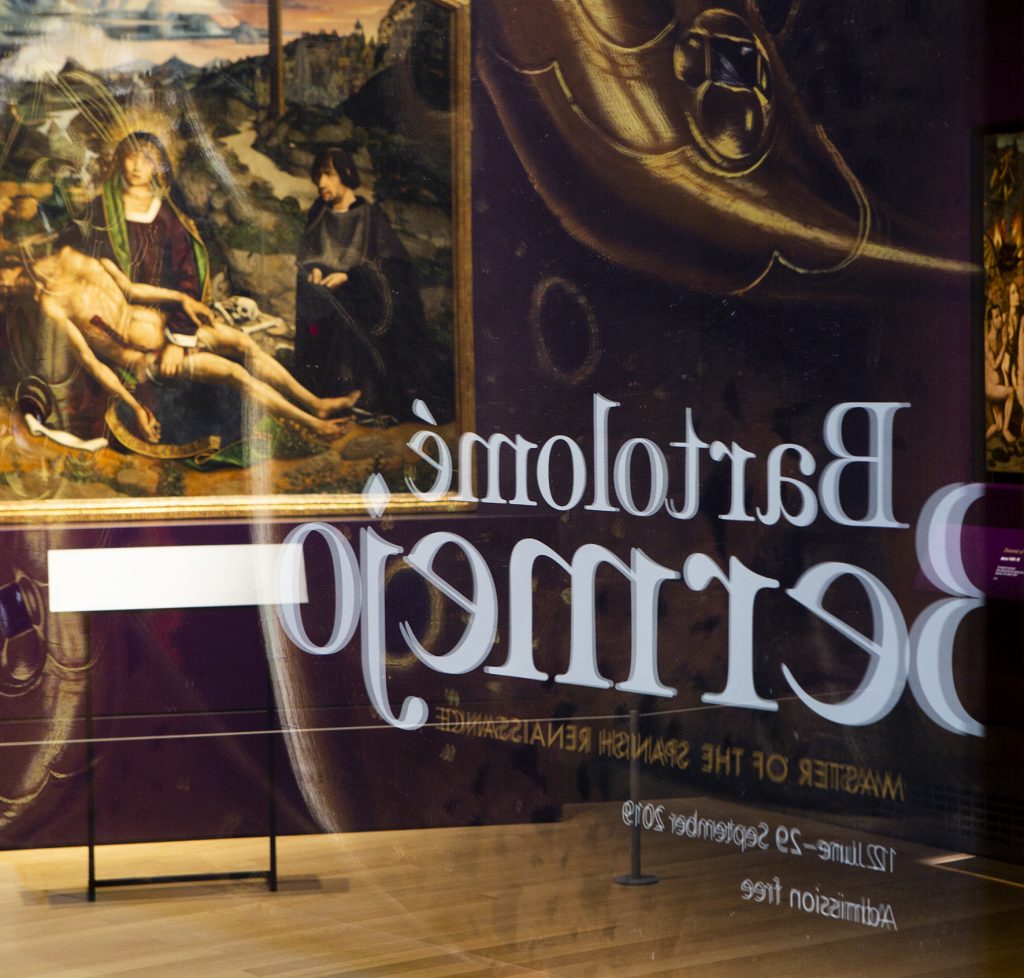
What projects have you worked on recently?
Since I started working at the National Gallery, I have worked on numerous exhibitions. My initiation rite was with one of the heavyweights of the Renaissance and his disciple: Michelangelo & Sebastiano. The truth is that I will never forget it. I entered when the exhibition was already half completed and I had to catch up with everything as fast as I could to not disappoint the expectations of my employers, and of course my own. This situation was a stressful, especially because I was not working in my mother tongue, but it was also immensely satisfying once it was finished.
During my 3 years at the National Gallery, I have designed approximately 14 exhibitions including 3 exhibits of Spanish monographs from a range of different time periods.
In 2017, at the centrepiece of the Self-portraits exhibition we had the Spanish baroque painter, Murillo. The central paintings were all on loan from the New York Frick collection which included and our famous self-portrait. It shows a more experienced Murillo with his hand outside the frame, building A magnificent trap.
At the beginning of 2019, we jumped from the Baroque to the Impressionism of the 19th century. During this time, I had the magnificent opportunity to design the Sorolla exhibition: Spanish Master of Light and collaborated closely with his great-granddaughter, Blanca Pons-Sorolla. I can also thank my very talented companion and friend, Akemi Herráez Vossbrink, curator of the exhibition together with Chris Riopelle for their help. On this occasion, the title of the exhibition gave me the key to the concept of design: The Light. Here the challenge was that of how to introduce the feeling of being in one of the beautiful landscapes of the impressionist painter. The concept was clear, the methods for obtaining it not so much. After several meetings with our lighting technicians, I envisioned the possibility of projecting Sorolla’s name on a large scale and introducing diffused light by means of gobos at the entrance to the exhibition space that simulated light passing through the leaves of the trees. I have to say that I experienced an almost childlike joy throughout the entire process of the Sorolla exhibition. In everything from the beginning of the creative concept to the design of the leaflets with translucent paper which made them so enticing that they sold out in 2 weeks rather than the predicted 2 months. The public reception was exceptional; the attendance expectations tripled and even today, when the exhibition closed several months ago, I am frequently met with members of the public who tell me that they were so moved by the painter that, even though he was unknown to them initially, now they will never forget him.
2019 also saw an even greater leap from Impressionism to the Gothic, Bartolomé Bermejo: Spanish Master of the Renaissance. This exhibition was a collaboration with the Prado Museum and the MNAC of Barcelona and was a great opportunity for me as a designer to bring Classic design into a more theatrical production. I incorporated the use of three-dimensional letters in gold, botanic elements which have a strong symbology in Bermejo as well as rhinestones (pearls and cabochons) to accentuate the jewellery elements frequently included in the production of the painter.
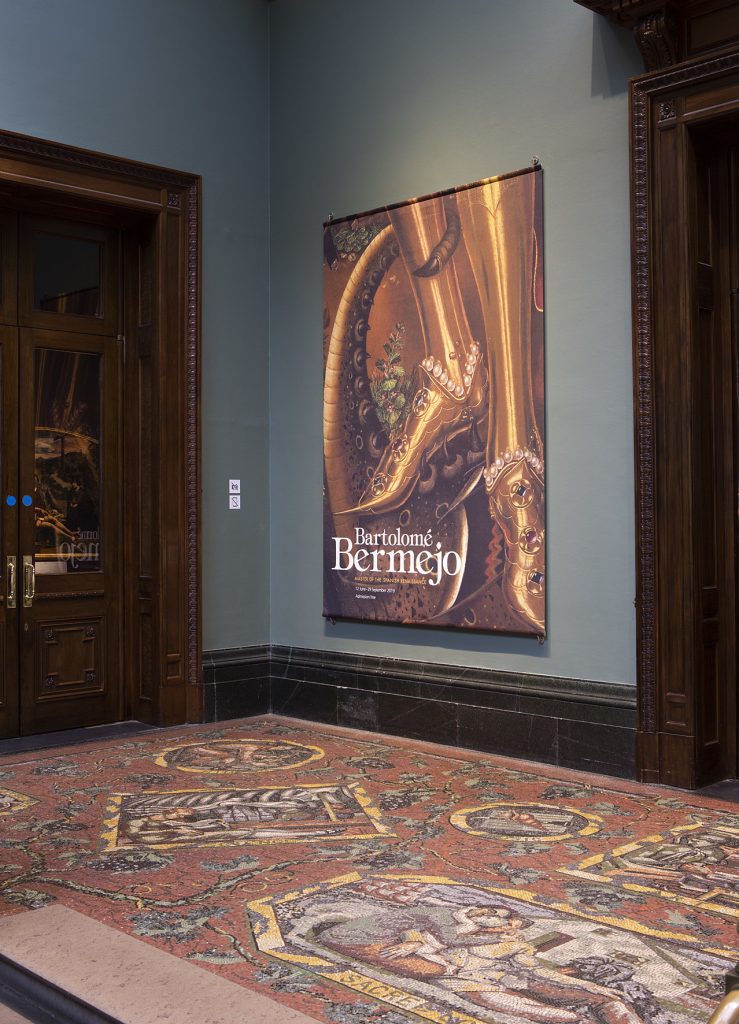
Who or what inspires you to do your work?
Inspiration comes when you least expect it. Sometimes walking through the forest, suddenly you see how the light hits the ground as it passes through the leaves and there you have it. Sometimes you stop to look at a shop window and there are those pearls that capture the light in a wonderful way, and you think, what if we put them next to Bermejo? They would look so beautiful. But most of the time it is a combination of observing your surroundings, absorbing inspiration (often from other exhibitions, photographs, theatre sets, ballet, opera and even passionate conversations with friends and colleagues) and looking in detail at the paintings included in the exhibition. The works themselves will always give you the keys to the consistency of the design. Sometimes there are slight artistic disparities between the visions of curators but the truth is, it is wonderful to work with the team of curators of the National Gallery. I feel that they love my work and this leads me to always want to do my best and go one step further whilst also helping and encouraging them.
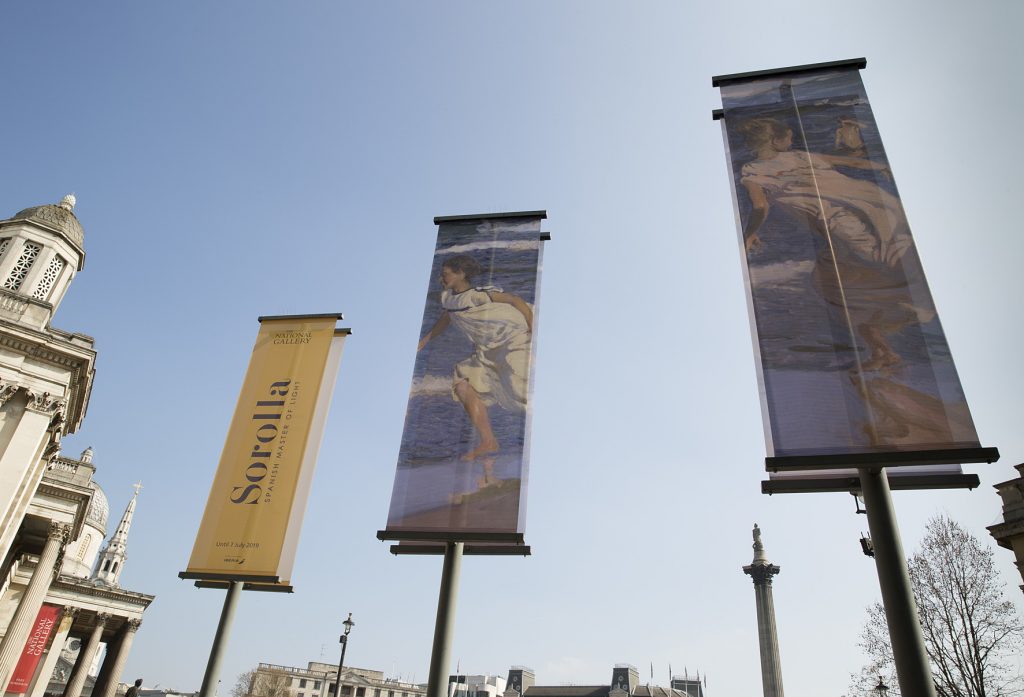
What places do you recommend in London as a designer?
I always like to visit other museums that inspire me and hold such knowledge. I usually like to go to the Design Museum, the Tate (in fact, since I have mentioned the theme of light, I highly recommend going to see Olafur Eliasson’s facilities) and the Victoria & Albert Museum. The Summer Exhibition at the Royal Academy is always very fun, I highly recommend it, in fact I have some projects programmed for next year. Clerkenwell Design Week is also always inspiring and varied and I recommend being aware of Central St Martins and Goldsmiths University’s exhibitions. I always enjoy being inspired by bookstores and even seeing the designs of artists in showcases of luxury stores (especially at Christmas), which are abound here in London: those of New Bond Street are particularly beautiful.

What projects are you working on at the moment?
At this moment, I just opened Leonardo: An Immersive Experience, in which I have been in charge of creating the Blue Angel (which we are using for the marketing campaign and the cover of the catalogue). It is a mixture of layers upon layers in Photoshop with different opacities and fusion modes, combining Leonardo’s work with microscopic pigments of the painting. It has been the most interesting and enriching collaboration alongside my partner in the scientific department, Marika Spring. It is then followed by Nicolaes Maes: Dutch Master of the Golden Age, in the same space as Leonardo in February 2020. At the moment I am immersed in the creative concept of the next exhibition in room 1, SIN. It promises everything and more and it will be a fantastic effort to bring religious themes into an increasingly secular society in an engaging and relevant way.

Belen Cao, la diseñadora española en las exposiciones de la National Gallery

Belen Cao es licenciada en Periodismo y Comunicación Audiovisual por la Universidad Antonio de Nebrija de Madrid (2009). Siempre le han interesado mucho tanto la escritura como el dibujo por esta razón, mientras trabajaba en gabinetes de prensa pequeños, empezó a redirigir su carrera hacia el Diseño Gráfico.
En 2012, Cao completó un máster profesional en esta materia de un año en la escuela Trazos de Madrid. Seguido de un año en Ilustración Digital en la escuela ESDIP de Madrid (2014) y finalmente, un Master of the Arts en la Universidad Kignston de Londres en Diseño Gráfico y Comunicación Visual en el que se licenció con honores en 2016. Siempre intercalando periodos de no estudio con cursos breves de animación, dibujo, tipografía y métodos de impresión.
Cao comenzó su trayectoria en la National Gallery de Londres en diciembre de 2016 tras un breve periodo de voluntariado como profesora de arte en un colegio de primaria del sureste de Londres que compaginaba con un trabajo como diseñadora freelance para Associated Studios, una escuela de formación para jóvenes estudiantes de Teatro y Ópera.

¿En qué proyectos has trabajado recientemente?
Desde que empecé a trabajar en la National Gallery, he trabajado en numerosas exposiciones. Mi rito de iniciación fue con uno de los pesos pesados del Renacimiento y su discípulo: Michelangelo & Sebastiano. La verdad es que nunca lo olvidaré porque entré cuando la exposición estaba ya a medio construir y me tuve que poner al día con todo tan rápido como pude para no defraudar las expectativas de mis empleadores, y por supuesto las mías propias. Esta situación fue un poco estresante, –sobre todo porque no estaba trabajando en mi lengua materna– aunque también una gran satisfacción cuando estuvo terminada.
Si no recuerdo mal, durante estos tres años, he diseñado 14 exposiciones, tres de ellas monográficas de artistas españoles de muy diversos periodos.
Del barroco español fue en 2017 la exposición Murillo: The Selfportraits, que tuvo como figuras centrales el Autorretrato de la Frick collection de Nueva York y nuestro famoso autorretrato en el que, un Murillo ya más experimentado, se retrata con la mano fuera del marco construyendo un magnífico trampantojo.
A principios de 2019, saltamos del Barroco al Impresionismo del siglo XIX, cuando tuve la magnífica oportunidad de diseñar Sorolla: Spanish Master of Light y colaborar estrechamente con la bisnieta del pintor Blanca Pons-Sorolla y con mi muy talentosa compañera y amiga, Akemi Herráez Vossbrink, comisaria de la exposición junto con Chris Riopelle. En esta ocasión el mismo título de la exposición me dio la clave para el concepto del diseño: La Luz. Aquí el reto fue, cómo introducir la sensación de estar en uno de los bellísimos paisajes del pintor impresionista en un piso menos 2 en las profundidades de la National Gallery. El concepto estaba claro, los métodos para consegurilo no tanto. Tras varias reuniones con nuestros técnicos de iluminación vislumbré la posibilidad de proyectar el nombre de Sorolla a gran escala e introducir luz difusa mediante gobos en la entrada al espacio expositivo que simulaba luz pasando a través de las hojas de los árboles. Tengo que decir que disfruté como una niña durante toda la elaboración de Sorolla, desde los principios del concepto creativo hasta el diseño de folletos con papel traslúcido que realicé para repartir en la galería (debían haber durado 2 meses y se agotaron en 2 semanas). La acogida del público fue excepcional, creo recordar que se triplicaron expectativas de asistencia y aun hoy, cuando la exposición cerró hace ya varios meses, los vigilantes de la galería cuando me ven pasar me cometan con añoranza cuánto les emocionó la obra de un pintor del que ni siquiera antes habían oído hablar pero que ahora ya no olvidarán.
En el mismo 2019, un salto aun mayor desde el Impresionismo al Gótico, Bartolomé Bermejo: Spanish Master of the Renaissance, que hemos realizado junto con el Museo del Prado y el MNAC de Barcelona ha sido una estupenda oportunidad para mí como diseñadora de acercar el diseño clásico a una producción más teatral al haber podido incluir el uso de letras tridimensionales en color oro, elementos de botánica con una fuerte simbología en los cuadros de Bermejo y pedrería (perlas y cabuchones) como guiño a elementos de joyería frecuentemente incluidos en la producción del pintor.

¿En quién o qué te inspiras para hacer tus trabajos?
La inspiración llega cuando uno menos lo espera. A veces paseando por el bosque de repente ves como la luz incide en el suelo al pasar por las hojas y ya lo tienes. A veces te detienes a mirar un escaparate y ahí están esas perlas que capturan la luz de una forma maravillosa, y piensas, ¿y si las ponemos junto a Bermejo?, ¿Se verían tan hermosas. Pero la mayoría de las veces consiste en una combinación entre observar lo que te rodea, absorber la inspiración (muchas veces procedente de otras exposiciones, fotografías, decorados de teatro, ballet, ópera e incluso conversaciones apasionadas con amigos y compañeros) y mirar con detalle las pinturas incluidas en la exposición: ellas te dan las claves para hacer un diseño congruente con los cuadros e incluso a veces ir un paso más allá si te lo permiten los comisarios –normalmente ambas partes deben hacer concesiones–. Pero lo cierto es que es una maravilla trabajar con el equipo de comisarios de la National Gallery. Siento que les encanta mi trabajo y ello me lleva a querer siempre dar lo mejor e ir un paso más allá.

¿Qué lugares recomiendas en Londres como diseñadora?
Siempre me gusta visitar otros museos que me inspiren y aporten conocimientos. Normalmente me gusta mucho ir al Design Museum, al Tate (de hecho, ya que he mencionado el tema de la luz, recomiendo muchísimo ir a ver las instalaciones de Olafur Eliasson) y al Victoria & Albert. La Summer Exhibition de la Royal Academy es siempre muy divertida, la recomiendo muchísimo, de hecho tengo unos proyectos preparados para presentar el año que viene. Clerkenwell Design Week es siempre inspiradora y variopinta. También recomiendo estar al tanto de lo que hacen Central St Martins y Goldsmiths university.
Siempre disfruto inspirándome en librerías e incluso viendo los diseños de artistas en escaparates de tiendas de lujo (sobre todo en Navidad), que aquí en Londres abundan, por ejemplo son muy bonitas las de New Bond Street.

¿En qué proyecto estás trabajando ahora?
Hace poco abrió Leonardo: An Immersive Experience, en la que me he encargado de crear el Ángel Azul (que estamos usando para la campaña de marketing y la portada del catálogo) producto de una mezcla de capas y capas en Photoshop con diferentes opacidades y modos de fusión, combinando la obra de Leonardo con pigmentos microscópicos del cuadro. Una colaboración de los más interesante y enriquecedora pertrechada junto con mi compañera del departamento científico Marika Spring. Le sigue Nicolaes Maes: Dutch Master of the Golden Age, en el mismo espacio que Leonardo en febrero de 2020.
En estos momentos me encuentro inmersa en el concepto creativo de la próxima exposición en room 1, SIN. Promete todo y más y será un fantástico esfuerzo para acercar la temática religiosa de una forma interesante a una sociedad cada día más laica.

“La casa de los espíritus is a cry for freedom, human rights and the history of women”
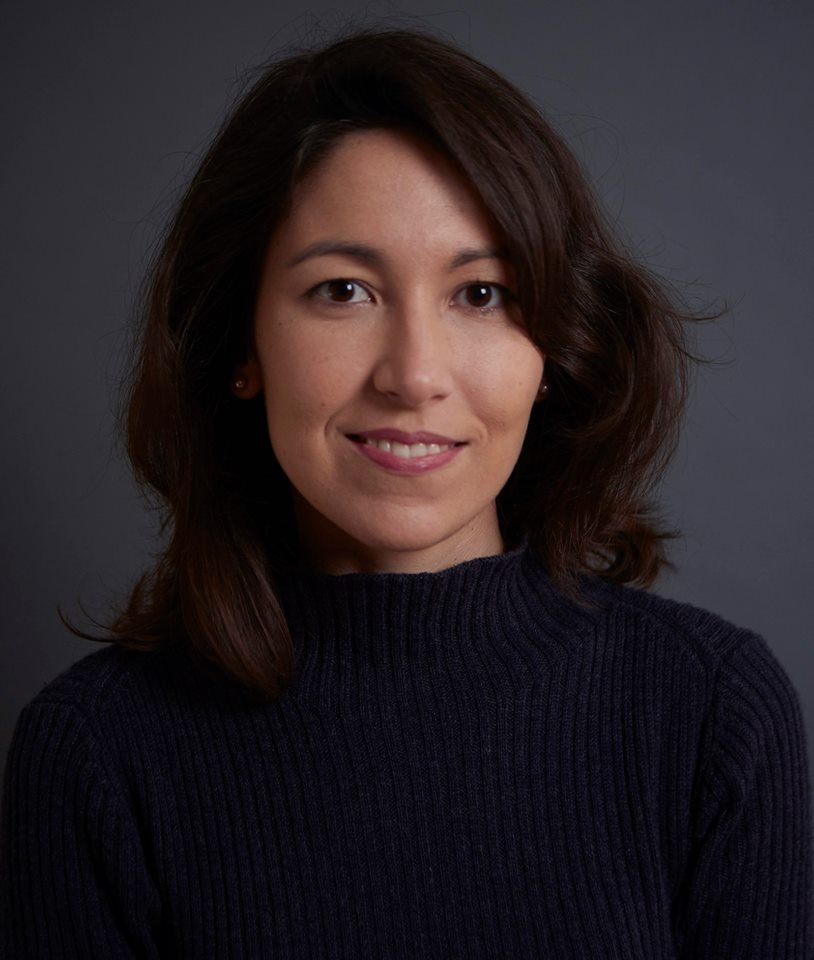
We chat with Paula Paz, associate director at Cervantes Theatre, who is currently directing La casa de los espíritus, a novel by Isabel Allende adapted for theatre in both Spanish and English by Caridad Svich.
Performances of the play in London continue until December 11th.
Why La casa de los espíritus?
We wanted to choose La casa de los espíritus this year because we wanted to dedicate it to all the creative women everywhere. Now, as we come to the end of the year, it has become our biggest production of 2019. In previous years, we showcased Bodas de Sangre, La Casa de Bernarda Alba and Yerma by Lorca. But this year, we wanted to choose an author of renown with a work that many people would know and love which would attract enough attention to catch a Spanish and Latin American audience.
When contacted Isabel Allende, we already knew of the adaptation for the theatre translated by the American playwright Caridad Svich. Svich, who speaks both Spanish and English, also has ancestry from several Latin American countries and wrote the adaptation of La casa de los espíritus several years ago. It has been performed in several theatres across the United States and Mexico but never in the United Kingdom or Spain.

Allende transferred the rights and gave us the permission to perform it here. Initially there were difficulties due to the current recording of the television adaptation of La casa de los espíritus but thankfully, Allende intervened in the process to help us stage it here. And that’s how we embarked on this adventure with a grand total of 12 actors in the cast. It is the greatest work we have ever undertaken at the Cervantes Theatre. Not only of the size of the team, but also of the epic scale of this work which mixes four generations, the history of an entire family as well as a country whilst also crossing between time, spirits, etc. It is a wonderful work but it is also very complex at the same time. It requires a full set of scenery, lighting and sound which work together to create an inclusive atmosphere so that this story can become universal; about all families in all countries around the world. Although the novel never tells us the location of the Trueba family home, my guess is that it could be any country in Latin America, or indeed: any country in the world. This story resonates with everyone.
While directing La casa de los espíritus, I saw how history repeats itself through the narrative. I also found it very beautiful to see the importance of words on an individual, social and global level. The written word enables personal experience to transcend history and gives it the possibility to serve others so as not to not repeat the same mistakes from the past.

What is it like to work with a team of 12 actors?
We have a multilingual cast for both the Spanish and English performances of the play which is rare because we usually have two different casts or a mix. In this case, we did it to maintain the essence of the story which has firm roots in Latin America. We therefore wanted the English translation to resemble the language of Latin America.
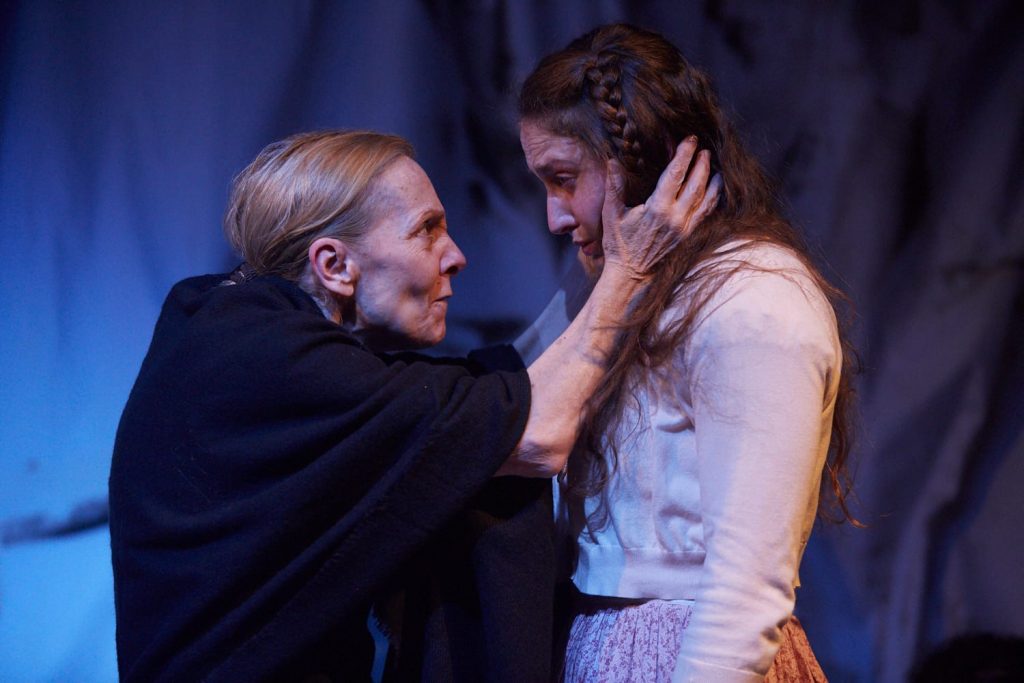
Why would you advise that the students of the Instituto Cervantes should come to see the work?
I recommend that they read the novel before they come because it is wonderful and everyone should read it. Secondly, it will inform their viewing of the play and make them more aware of the linguistic elements. It is a cry for freedom, for human rights and for awareness of the contribution that women have made to history. Depending on the level of Spanish that students have, they could come and see it in English first and then in Spanish, so they learn well about the story and the characters and then they appreciate the nuances in Spanish.
“La casa de los espíritus es un grito a la libertad, a los derechos humanos y a la historia de las mujeres”
Charlamos con Paula Paz, directora asociada del Cervantes Theatre y directora del montaje de la obra que, basada en la novela La casa de los espíritus de Isabel Allende y traducida por Caridad Svich, se representa en Londres hasta el próximo 11 de diciembre.

¿Por qué La casa de los espíritus?
Quisimos elegir La casa de los espíritus para este año, que está dedicado a las mujeres creadoras. Ahora, a finales de año, que hacemos la producción más grande del año, los primeros años hicimos a Lorca, con Bodas de sangre, La casa de Bernarda Alba y Yerma. Este año, quisimos elegir a una autora de esa envergadura con una obra que conociera mucha gente y que pudiera llamar la atención y atraer a un público tanto español como latinoamericano. Contactamos con Isabel Allende, nosotros conocíamos la adaptación de la dramaturga norteamericana Caridad Svich, quien tiene ascendencia de varios países latinoamericanos, con lo cual ella habla español y habla inglés. Ella había hecho la adaptación de La casa de los espíritus hace ya varios años y se había presentado en varios teatros de Estados Unidos y México, pero nunca en Reino Unido y nunca en España.

Isabel Allende nos dio los derechos, y estuvo difícil porque van a hacer una serie de televisión de La casa de los espíritus, y estaban comprometidos, pero Isabel intervino para poder hacerlo. Y así fue como nos embarcamos en esta aventura, con 12 actores en el reparto. Es la obra más grande que hemos hecho en el Cervantes Theatre hasta el momento. No solo de envergadura del equipo, sino también de lo épico de esta obra, que mezcla cuatro generaciones, la historia de una familia entera, de un país y cruce entre tiempo, los espíritus, etc. Es una obra maravillosa pero muy compleja a la vez. Requiere de un arrope de escenografía, de iluminación y de sonido para que pueda llegar esta historia de una familia de un país, y del mundo, que se puede extrapolar.
Aunque en la novela no se dice dónde está la familia Trueba, pero sí que puede ser cualquier país en Latinoamérica y cualquier país del mundo.
Además, se ve cómo la historia se va repitiendo, y también me parece muy bonito, dirigiendo La casa de los espíritus, que he tratado de que se mantuviese, junto con la importancia de la palabra, a nivel individual, social y global de la historia de un país, como la historia que se escribe y trasciende tiene una influencia para que sirva a los demás y no se vuelvan a repetir los errores del pasado.

¿Cómo es trabajar con el equipo de 12 actores?
Es el mismo reparto para la obra tanto en español como en inglés, si bien normalmente hacemos dos repartos diferentes o una mezcla. En este caso, para mantener la esencia de esta historia, que pertenece a Latinoamérica, hemos querido que en inglés también tenga un aire de Latinoamérica.

¿Qué aconsejas a los alumnos del Instituto Cervantes que vengan a ver la obra?
Yo recomiendo que si pueden lean la novela porque es maravillosa y que todo el mundo tiene que leer. Es un grito a la libertad, a los derechos humanos y a la historia de las mujeres y como la ayuda entre ellas hace que avance el mundo. Y dependiendo del nivel de español que tengan, que vengan a verla en inglés primero y luego en español para enterarse bien de la historia y de los personajes y luego ir apreciando los matices en español.
Bartolomé Bermejo, el gran pintor de la Corona de Aragón, seduce en Londres

La comisaria becada de la exposición de la National Gallery “Bartolomé Bermejo. Maestro del Renacimiento Español”, la madrileña Akemi Luisa Herráez Vossbrink, ha ofrecido una conferencia sobre la vida y obra de este pintor español, organizada por el Instituto Cervantes de Londres en la sede de la National Gallery y en colaboración con el museo londinense.
Bartolomé Bermejo (h. 1440-h. 1501), un maestro de origen cordobés que desarrolló su actividad profesional en los territorios de la Corona de Aragón, fue una de las personalidades más fascinantes del panorama artístico de la segunda mitad del siglo XV, con una vida itinerante que, cuando menos, le llevó a trabajar en Valencia, Tous, Daroca, Zaragoza y, finalmente, Barcelona.
“Es increíble tener las siete obras aquí y probablemente no se dará otra vez en mucho tiempo”, explicó Herráez, en relación a la muestra en la capital británica, que permanecerá abierta hasta el próximo 29 de septiembre. Por su parte, el director del Instituto Cervantes de Londres, Ignacio Peyró, destacó “lo excepcional de haber tenido, en tan poco espacio de tiempo, a Murillo, Sorolla y Bermejo, tres pintores españoles, en una institución de talla mundial como es la National Gallery”.
La charla de Herráez se centró en las siete pinturas de la exposición, haciendo un análisis de su contexto y trazándolas en relación a la carrera artística de Bermejo. Entre ellas, el “San Miguel”, el tríptico de “Acqui Terme” y la “Pietà Desplà” recibieron especial atención, mediante la comparación de sus donantes, su producción, su localización y su contexto histórico.

El “San Miguel” es la única obra de Bermejo en suelo británico, mientras que el resto de piezas de la muestra han viajado por primera vez a Londres para esta ocasión. Una experiencia excepcional, más aún cuadros como el de “La Virgen de Monserrat” o la “Pietà Desplà” habían estado casi 500 años sin moverse de la catedral de Acqui Terme y de la catedral de Barcelona respectivamente.
La National Gallery restauró hace unos años el cuadro “El Triunfo de San Miguel sobre el Diablo”, lo que ha permitido mostrar la obra maestra más temprana de Bermejo, el artista español del Renacimiento, cuya técnica pictórica, mezclando rasgos de la pintura flamenca y española, no tuvo parangón entre sus contemporáneos españoles.
La muestra tiene lugar en Londres, tras celebrarse dos grandes exposiciones de Bermejo en el Museo del Prado en Madrid y en el Museo Nacional de Arte de Cataluña (MNAC) en Barcelona, que mostraban unas 48 piezas de diferentes épocas de la carrera de Bermejo, de su taller, copias y objetos comparativos.

Gran acogida
La exposición de Bermejo en la National Gallery, que dirige Gabriele Finaldi, y con Letizia Treves como comisaria principal, está teniendo muy buena acogida entre el público británico a lo largo del verano. Muchos de los visitantes reconocían el “San Miguel”, que ya habían visto durante años en la National Gallery, pero ahora pueden admirarlo restaurado.
“Antes se habían perdido muchos detalles, de las plantas, el barniz se había vuelto amarillento y, sobre todo, el oro de arriba se había perdido. Entonces el conservador, un dorador externo y el equipo científico de aquí lo trataron, y gracias a eso, pudimos empezar el proyecto. Además, se escribió un ensayo técnico sobre las investigaciones que se hicieron en el momento y se publicó en el catálogo de la exposición de Londres dedicado solo al “San Miguel” y a su contexto”, añade Herráez.
Herráez también cree que al público le fascina la atención de Bermejo por los detalles, sobre todos los animales y las plantas. “Es algo que al público le encanta, así como el lado cómico de los demonios.»
Bartolomé Bermejo, the great painter of the Crown of Aragon, seduces in London

The curatorial fellow of the National Gallery exhibition “Bartolomé Bermejo. Master of the Spanish Renaissance”, Akemi Herráez Vossbrink, gave a lecture on the life and work of this Spanish painter, organized by Instituto Cervantes in London in collaboration with the National Gallery.
Bartolomé Bermejo (h. 1440-h. 1501), a Spanish Master from Cordoba who worked in the territories of the Crown of Aragon, was one of the most fascinating personalities of the artistic panorama of the second half of the fifteenth century. He led an itinerant lifestyle, working in Valencia, Tous, Daroca, Zaragoza and, finally, Barcelona.
“It is incredible to have seven of his works here. This will probably not happen again in a long time,” said Herráez, in relation to the exhibition in the British capital, which will remain open until September 29. In addition, the director of Instituto Cervantes in London, Ignacio Peyró, highlighted “the exceptional thing about having, in such a short space of time, Murillo, Sorolla and Bermejo, three Spanish painters, in a world-class institution such as the National Gallery”.

Herráez’s lecture focused on the seven paintings in the exhibition, analysing their context and considering them within the development of Bermejo’s artistic career. Among them, the “Saint Michael”, “The Virign of Montserrat” and the “Pietà Desplà” received special attention comparing their patrons, craftsmanship, location and historical context.
“Saint Michael” is Bermejo’s only work on British soil, while the rest of the pieces in the exhibition travelled to London for the first time for this occasion. An exceptional occurrence, other paintings such as “The Virgin of Montserrat” and “Pietà Desplà” had not previously been moved for almost 500 years from their respective cathedrals of Acqui Terme and Barcelona.
A few years ago, the National Gallery restored the painting “Saint Michael triumphant over the Devil with the Donor Antoni Joan.” This restoration highlighted Bermejo’s masterful technique, mixing features of Flemish and Spanish painting, in a painting that has no equal among his Spanish contemporaries.
The exhibition takes place in London, after two major Bermejo exhibitions were held recently at the Prado Museum in Madrid and at the National Museum of Art of Catalonia (MNAC) in Barcelona, both showing around 48 pieces from different periods of Bermejo’s career, including works by the master, his contemporaries, copies and other comparative objects.

Warm welcome
Bermejo’s exhibition at the National Gallery, directed by Gabriele Finaldi and with Letizia Treves as the main curator, has been well received by the British public over the course of the summer. Many of the visitors recognized the “Saint Michael”, which they had seen for years in the National Gallery, but now they can admire it in its restored form.
“Previously, many details of the plants had been lost, it was quite brown and, most noticeably, the gold above had been practically lost. Before the exhibitions, a conservator, an external gilder and the scientific team here restored it, and thanks to that, we were able to start the project. A technical essay was written on the investigations that were done at the time and published in the London exhibition catalogue dedicated exclusively to Saint Michael and its context,” added Herráez.
Herráez also believes that the public is fascinated by Bermejo’s attention to detail, especially by the animals and plants. “It’s something that the public loves, as well as the comical aspect of the demons.”
Ecuador y España reivindican en Londres a Guayasamín como uno de los grandes artistas y testigos del siglo XX
El Instituto Cervantes celebra el centenario del artista con una conferencia de Daniela Galán y Estefanía Solórzano en el marco del Día Nacional del Ecuador
La Embajada del Ecuador y el Instituto Cervantes celebran en Londres los 100 años del natalicio del gran pintor y artista ecuatoriano Oswaldo Guayasamín, con una conferencia de la artista e historiadora de arte de la Universidad Goldsmiths, Daniela Galan, y la antropóloga de danza, bailarina y actriz, Estefania Solórzano.
«Como embajador del Ecuador en el Reino Unido, es un honor conmemorar el jueves 8 de este mes, en el Instituto Cervantes de Londres, el centenario del nacimiento del artista Oswaldo Guayasamín, un gigante del Ecuador y de América, cuya obra es conocida alrededor del mundo. Sus creaciones plásticas conmueven por su fuerza estética y el mensaje perdurable de las obras eternas”, explica Jaime Alberto Marchán Romero, Embajador del Ecuador ante el Reino Unido.
Marchán Romero destaca que el maestro ecuatoriano dominó todas las expresiones de su arte: lienzo, composición mural, escultura, grabados, entre otras, y que, en el ámbito intelectual, desempeñó un papel decisivo en la lucha por sus ideales de justicia social. “A través de su pincel, habló por los oprimidos del mundo. Su grito fue inmenso y aún resuena, iracundo y altivo, en museos, ágoras, muros y plazas, pero, sobre todo, en el corazón de los hombres”, añade.
El Embajador considera que este evento en el Instituto Cervantes en la capital inglesa tiene una significación especial, pues es una oportunidad para dar a conocer mejor la obra del gran artista ecuatoriano en este país cosmopolita y para renovar también con el Instituto Cervantes “los profundos lazos que unen a los países iberoamericanos mediante la lengua, la cultura y el arte, a través de las cuales nos hemos enriquecido mutuamente”.
“Guayasamín es un artista que parece resumir la grandeza y las contradicciones de Hispanoamérica. Más allá de su potencia plástica, tan característica y tan ligada a las tradiciones del subcontinente, todos los temas hispanoamericanos están en él. Y digo hispanoamericanos porque pocos artistas han hecho tan bien de puente entre América y España. Para nosotros es una alegría abrir las puertas a Guayasamín y al Ecuador en su día nacional”, señala el director del Instituto Cervantes de Londres, Ignacio Peyró.
En Ecuador, cuando Estefania Solórzano inició sus estudios de teatro, empezó a ir mucho a los museos y además se acercó a la pintura, la danza y la literatura ecuatoriana. Fue ahí cuando también redescubrió la obra de Guayasamín y empezó a frecuentar el museo ‘La capilla del hombre’, en Quito, construido por el artista en homenaje al ser humano.
La expresión más íntima del ser humano
Guayasamín estuvo siempre rodeado de muchos amigos artistas (pintores, músicos, escritores, etc.) y Solórzano se interesó por conocer la historia de ese círculo. “Siempre me llamó la atención de Guayasamín el enfoque en los ojos, las manos y el rostro. Lo veo como la manera en la que uno llega a conocer a otra persona a través de la mirada. Guayasamín nos propone la expresión más íntima del ser humano en los ojos y en las manos, y es ahí donde están el terror, el amor, la ternura y la poesía”, explica.
Solórzano comenzó su Máster en Antropología de la Danza hace dos años, en un itinerario que la llevó a Noruega, Francia, Hungría y finalmente a Reino Unido, el pasado mes de enero. En la actualidad, desarrolla un proyecto basado en la memoria y el olvido, para el que se inspiró en una de las obras de Guayasamín: “Mientras viva siempre, te recuerdo”, que pertenece a la serie ‘La edad de la ternura’.
“La piel afuera, la piel adentro”
Solórzano se identifica con Guayasamín y su idea de “La piel afuera, la piel adentro”. En el primero, Guayasamín hace referencia a su trabajo artístico en el tiempo que le ha tocado vivir; mientras que, en el segundo término, engloba todas las experiencias de niño y lo que vivió con su familia, unos hechos que le conmovieron toda su vida.
Guayasamín describe que pintó ‘La edad de la ira’ como si gritara desesperadamente, sumándose a todos aquellos gritos que expresan la humillación y la angustia de los hechos de horror vividos por la Humanidad en el siglo XX.
En el caso de la historiadora Daniela Galan, su charla gira sobre la importancia del artista en el contexto de la historia del arte latinoamericano y su impacto en la construcción de la escena artística mundial. La ira será el punto de partida para examinar cómo Guayasamín y otros artistas abordan lo indescriptible, situaciones de dolor, trauma y violencia, sin caer en el sensacionalismo.
“En los cuadros de Guayasamín se puede ver no solamente el dolor de las víctimas, si no la frustración de vivir en ciertos momentos históricos y de haber vivido tanto dolor, como el Holocausto, la Guerra Civil española o las bombas de Hiroshima y Nagasaki”, explica Galan, para quien Guayasamín es indispensable en la historia del arte latinoamericano para hacer un grito a los derechos de los indígenas, con su mezcla de indígena y mestizo.
Ecuador and Spain introduce Guayasamín in London as one of the great artists and witnesses of the 20th century
The Embassy of Ecuador and Instituto Cervantes celebrate, in London, the 100th anniversary of the birth of the great Ecuadorian painter and artist Oswaldo Guayasamín, with a conference by Goldsmith University art historian and artist Daniela Galán and the dance anthropologist, dancer and actress Estefanía Solórzano.
«As Ambassador of Ecuador in the United Kingdom, it is an honor to commemorate this month, at Instituto Cervantes in London, the centenary of the birth of the artist Oswaldo Guayasamin, a giant from Ecuador and America, whose work is known around the world, his plastic creations are moved by his aesthetic strength and the enduring message of eternal works,” explains Jaime Alberto Marchán Romero, Ambassador of Ecuador to the United Kingdom.
Marchán Romero emphasizes that the Ecuadorian master dominated all the expressions of art: canvas, mural composition, sculpture and prints. Romero added that, in the intellectual field, Guayasamín played a decisive role in the struggle for his ideals of social justice. “Through his brush, he spoke for the oppressed of the world. His cry was immense and still resonates, angry and haughty, in museums, walls and squares, but, above all, in the hearts of men,” he adds.
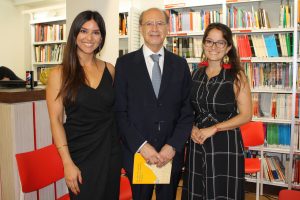
The Ambassador believes that this event at Instituto Cervantes has a special significance, as it is an opportunity to make the work of the great Ecuadorian artist better known in this cosmopolitan country. It also renews in Instituto Cervantes, “the deep ties that unite Latin American countries through language, culture and art, through which we have enriched each other.”
“Guayasamín is an artist who seems to summarize the greatness and contradictions of Latin America. Beyond its plastic power, so characteristic and so linked to the traditions of the subcontinent, all Latin American themes are in it. And I say Hispanic Americans because few artists have made such a good bridge between America and Spain. For us it is a joy to open the doors to Guayasamín and Ecuador on their national day, ”says the director of the Cervantes Institute in London, Ignacio Peyró.
In Ecuador, when Estefanía Solórzano began her theatre studies, she began to go to museums a lot and also approached Ecuadorian painting, dance and literature. It was at that time when she also rediscovered the work of Guayasamín and began to frequent the museum ‘La chapel of man’, in Quito, built by the artist in homage to the human being.
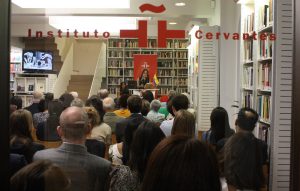
The most intimate expression of the human being
Guayasamín was always surrounded by many artist friends (painters, musicians, writers, etc.) and Solórzano was interested in knowing the history of that circle. “The focus on the eyes, hands and face always struck me. I see it as the way in which one gets to know another person through the eyes. Guayasamin offers us the most intimate expression of the human being in the eyes and hands, and that is where terror, love, tenderness and poetry are,” she explains.
Solórzano began her MA in Dance Anthropology two years ago, on an itinerary that took her to Norway, France, Hungary and finally to the United Kingdom last January. Currently, she develops a project based on memory and oblivion, for which she was inspired by one of Guayasamín’s works: “As long as I live forever, I remember you”, which belongs to the series ‘The age of tenderness’.
«The skin outside, the skin inside»
Solórzano identifies with Guayasamín and his idea of «The skin outside, the skin inside». In the first one, Guayasamín refers to his artistic work in the time he has lived; while, in the second term, he encompasses all the experiences of a child and what he lived with his family, facts that moved him all his life.
Guayasamín describes that he painted ‘The Age of Wrath’ as if he were screaming desperately, adding to all those screams that express the humiliation and anguish of the horror events experienced by Humanity in the twentieth century.
The construction of a world art scene
In the case of historian Daniela Galán, her talk revolves around the importance of the artist in the context of the history of Latin American art and its impact on the construction of the world art scene. Anger will be the starting point to examine how Guayasamín and other artists approach the indescribable, situations of pain, trauma and violence, without falling into sensationalism.
«In the paintings of Guayasamín you can see not only the pain of the victims, but also the frustration of living in certain historical moments and having lived so much pain, such as the Holocaust, the Spanish Civil War or the bombs of Hiroshima and Nagasaki», explains Galan, for whom Guayasamín is indispensable in the history of Latin American art. He also drew attention to the rights of the indigenous, with his mixture of indigenous and mestizo.
